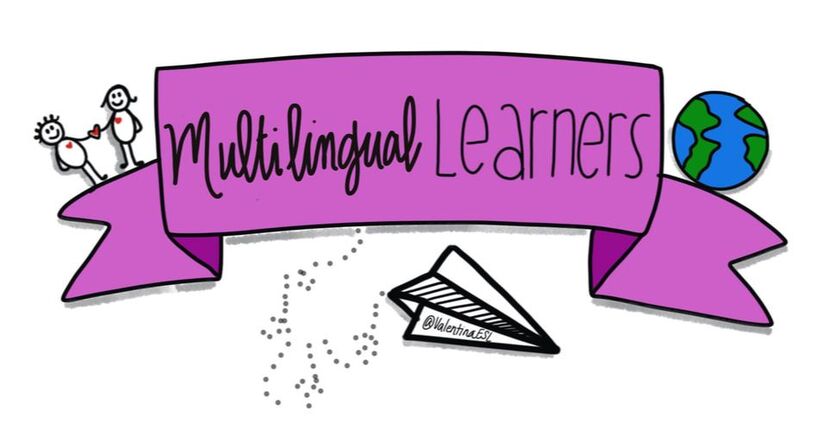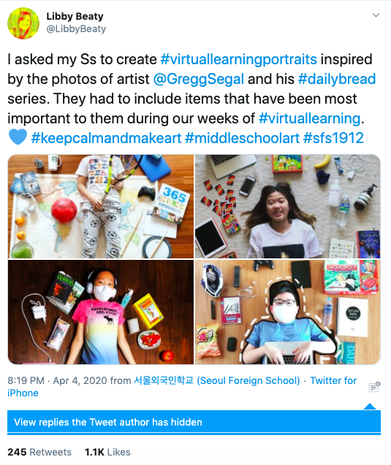|
Art teacher, Libby Beaty, teaches in Seoul, South Korea at Seoul Foreign Middle School. I came across her Twitter handle in April and was instantly hooked. But I didn’t know how much I would actually love her until after I asked her to answer a few questions for me. When I read her responses, my heart filled with joy and I couldn’t wipe the smile off my face. It was Teacher Appreciation Week and this is yet another example of a teacher we must celebrate! Here's the art project that Libby shared on Twitter and that she had her students do. It went pretty much viral. When I saw it, I reached out to Libby on Instagram and asked if I could “interview” her about her work. I asked her a series of questions. Here’s how it went. Valentina: Libby, I was inspired by a photograph you shared on Twitter shared in April which currently has over 1.1K likes. But before we get into that project specifically, can you tell us a bit about your teaching circumstances and the work you do with students in South Korea? How long have you been teaching there? What language(s) do you teach art in? Do you speak English and Korean? Libby: Hi Valentina! Thank you so much for reaching out to me from across the globe. :) I live in Seoul, South Korea with my husband and three children. I am currently teaching Art to Middle School students (6th, 7th and 8th grade) at Seoul Foreign School. We are in our third month of teaching virtually as I write this, but with hopes of returning to the classroom soon! My husband and I have been living and working internationally for 19 years. This is our third year in Korea. Prior to living in South Korea, we called Kentucky, Kenya, Qatar, India and Norway home. Students in international schools come from all over the world and while these students often speak multiple languages, the instruction at the schools where we have worked has always been in English. I wish I could speak Korean, but not yet unfortunately. Valentina: Wow, that’s fascinating. I can only imagine the rich cultural experiences! You asked your students to create #virtuallearningportraits. Can you tell us how this idea came about? Libby: Sure! I love photography and had remembered seeing the work of photographer Gregg Segal. He did a series called Daily Bread, photographing children around the world with the food they eat over the course of one week. I thought these photos were not only visually stunning but very powerful in what they portrayed. This series gave me the idea for the Virtual Learning Portraits and how we could create similar portraits, but showing what items are essential for us during virtual learning. I loved the idea of students giving a glimpse into their daily lives and I also knew it would be a reflective activity to think through what’s really important to them on a daily basis. I knew I was asking them to be somewhat vulnerable by photographing themselves and that is why I knew it would be really important for me to do this project first and provide my example to my students. So, I created a video of the process and a final photo to share with them. I think this is always the best thing to do...actually DO the project or assignment that we ask our students to do, but especially with this one. Valentina: Daily Bread sounds like an interesting series. Food definitely brings people together. I love how you were inspired by Gregg Segal’s work but you made it relevant and compelling to the students you work with. AND I love that you modeled the process for them! What were your instructions or requirements for the project? Libby: I asked my students to collect at least 15 items that have been most important to them during virtual learning and take a “bird’s eye view” photo of themselves surrounded by these items, keeping in mind the photos of Gregg Segal. I’m very happy to share the directions I gave my students. I often use Google Slides to create the directions for my projects. Here is the slide presentation for the Virtual Learning Portraits. Virtual Learning Portraits If anyone is interested in doing this project with their students, it should be easy enough to “make a copy” and then edit the slides to work best for them. Valentina: Thank you for sharing with everyone. I am a big advocate of sharing resources for the greater good! So how did students respond? And was the response typical or similar to other projects that you’ve done? Libby: My students did a fantastic job with this project. I told them they would most likely need someone to help them take the photo, due to the angle and because they need to be in the photo. I am very fortunate in that I work with students that are eager to learn and complete their projects. The thing that was different about this project was that I was asking them to photograph themselves and give us a glimpse into their homes and personal life. I knew this would make some of them feel uncomfortable, but I also knew that this vulnerability is what often allows us to connect with one another. One interesting thing to point out is that I haven’t had these students in the physical classroom yet. We went to virtual learning and then two weeks later I got all new students, so I feel like they were especially courageous with this project since we hadn’t even met in the physical classroom together. I know most of my 7th and 8th graders from last year, but all of my 6th graders are new to me. Valentina: I am blown away by this, Libby! I love how vulnerability plays a part in this project. You hit the nail on the head. It did take courage for them to share who they are, especially those new students who had not yet been in the physical classroom with each other yet. Once students completed their virtual learning portraits, how did they share them with each other? Libby: My students submit all of their work in Google Classroom and this works really well for us. However, this only allows me to see their work. If we were meeting at school, I would print their work and put it on display around the building (which hopefully I will still be able to do before the end of the year). So, other than sharing some of these photos out on Instagram for my students to see, they’ve not been able to see each other’s work like I would hope. I did recently do a virtual gallery tour of the work posted on our Instagram account so all of my students could get a glimpse of what their classmates are creating (especially for those that are not on Instagram). Valentina: I’m sure they enjoyed seeing each other’s work! Libby, there was a big response on social media to your project. Why do you think people are drawn to this one specifically? Libby: Yes, this has been so exciting to see and I love that teachers are willing to share their virtual learning portraits from all around the world. It’s really been incredible. I believe there has been such a big response to this project because it is something that everyone can relate to at this specific moment in time. I also think that vulnerability that I mentioned earlier draws us to the photos. We get a small glimpse into someone else’s life and find commonalities, simply in the fact that we are all stuck at home and dependent each day on certain items. Valentina: I agree. During these uncertain times, we still all long for connection. Now many educators are joining this initiative and asking their students to create virtual learning portraits. I’ve also seen educators creating virtual teaching portraits! How do you feel about the ripple effect that you started? Libby: I really think it’s incredible how this project is resonating with so many people. The online educator community has been wonderful and so supportive during this challenging time. I have relied on so many others throughout my teaching career and to be able to “give back” a little is a great feeling. While Gregg Segal has a book featuring photos from his Daily Bread series, I think it would be amazing to publish a book featuring all of these virtual learning portraits from around the world. I think that could be really powerful and a great way to document this significant time in history. Valentina: You should DEFINITELY publish a book like this! It will be a great documentary of what life was like for students during COVID19. Get the ball rolling! Libby, what role do you think art plays in language development? How do you embed listening, speaking, reading, and writing into art? Libby: I see art as a universal language and know that it can be a very powerful way to communicate when there is no other common language. This is why you can go into an art gallery anywhere in the world and be equally impacted by what you see as anyone else that views the same artwork, whether you speak the same language or not. I’m sure every Music and Drama teacher would say the same thing about what they teach. :) Learning to express ourselves artistically helps externalize our feelings in ways we might not be able to even if we do speak the same language. I see this in my classroom all the time. I learn so much about my students through the artwork they create! It opens doors for further conversations about who they are, what inspired their work and the decisions they made while creating. You asked how I embed listening, speaking, reading and writing into art. I ask my students to reflect and write in the digital Process Journals that they create while in my Art Class. They can do this through writing, video or a voice recording. I’ve done activities with my students where we listen to music and create artwork inspired by the music, or the same idea but with stories told through podcasts. I love having other artists come share with my students whenever possible. It’s nice for them to hear someone else’s voice and perspective about art rather than just mine all the time. :) I’ve had my students speak/present and share about art with their classmates in front of the whole class, but also in smaller groups, which is more comfortable for most students I think. I do share articles with my students about artists or artwork for them to read, but these are usually optional. I appreciate visuals with any directions I’m given and I try to provide the same for my students. In Middle School, I find interesting videos to be much more effective than sharing long articles as they have the benefit of listening while also seeing the visuals. So, I spend quite a bit of time trying to find ones that work best for my students and I frequently make my own. Valentina: I am inspired by your response. Honestly. It’s so wonderful to hear how art and language are deeply tied. They are inseparable. For many students, English learners or not, art and expression through arts is critical to academic success. How do you incorporate students’ culture into the work they do? Libby: This is something that is really important to me. I was a “third culture kid” growing up, having moved from Kentucky to the Democratic Republic of Congo at 12 years old and attending boarding school in Kenya. I understand the importance of culture and how this impacts who we are and in turn, impacts the art we create. I highly value the stories and experiences that each student brings to the learning environment in the classroom. This is what makes this space exciting, diverse and rich for learning empathy, creativity and kindness toward others. We have so much to learn from each other and combining our stories, experiences and artwork together is so powerful. When I create projects I try to allow choice as much as possible to allow students the freedom to express themselves and things that are important to them. I emphasize to my students that creating in connection with what is important to them will make the whole creation process so much more enjoyable, and more meaningful. I also try to highlight a variety of art and artists, especially from the country/location where I am teaching. I hope to expose my students to a wide variety of inspiration and give them the opportunity to share what inspires them as well. Who wouldn’t want to be an art student in Libby’s classroom? Thank you, Libby, for giving us a glimpse into your virtual learning portraits and into your work with students. You inspire me! Here’s how to connect with Libby and follow her teaching journey:
Twitter: @LibbyBeaty Instagram: @libbybeatystudentart Libby’s Bio: Libby Is an art teacher who, along with her husband and three children, has called Kentucky, Kenya, Qatar, India, Norway, and South Korea “home” over the past 20 years. She is passionate about art, creating, and sharing space with people who love the same things!
0 Comments
Your comment will be posted after it is approved.
Leave a Reply. |
Categories
All
|




 RSS Feed
RSS Feed
